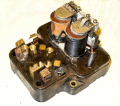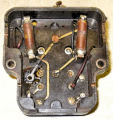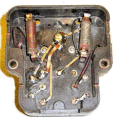
Regulator & Fusebox
The electrics were badly corroded, although are complete
March 2004:

The electrical control box hides behind these covers - the top box covers the Lucas type RF30 regulator; the lower box covers the terminals and fuses.

With the covers off, the regulator and fuses look a bit iffy - especially as two of the fuses have been wired across!

The twin wire connected over the top of the others is from the dynamo - it really needs a thicker red lead to carry twenty amps. The dynamo was rewired with 8amp cable for the field (green) and 22amp cable (brown) for the dynamo output.
Fortunately the junction boxes were easy to get at which made fault tracing easy.

I found that the auxiliary fuse blew if I operated the horn at the same time as the right trafficator.
The reason was found later - there was short in the wiring to the trafficator switch & horn push which someone had tried to "repair" by putting ever thicker fuses in - and ultimately wired across!
April 2004:

Corroded cut-out, regulator and fuses were dismantled, cleaned and adjusted.
A nasty intermittent charging fault was due to one of the fuse connectors having corroded underneath the control box - off with the box and the terminal connection remade with new screw and Araldite to reinforce the burnt bakelite base.
Very pleasing when it all worked first time and dynamo/regulator gave a steady charge to the battery. Regulator adjusted (cut-out contacts held open) to 15 volts which gives a healthy charge.
Max charge - ignition load only - 10 amps; with headlights on (total drain = 8 amps) the dynamo still gave 8 - 10 amps charge.

The red ignition warning light was not working - this must be the worst job on the car - as the holder had corroded and had to be replaced ----->>

The dashboard had to be taken out again to access the holder and the spring & clip method of fixing which was probably OK on the factory bench 70 years ago is a nightmare when working upside down in a restricted space.
It is important to retain the original bulb, which is a 2.5volt 0.2amp - # 252 MES torch bulb. These rarely blow - but the dropper resistance wound around the lampholder often fails, as had mine.
Any other type of bulb appears to create excessive sparking of the regulator points. I know, I tried it!
LATER - the sparking was found to be due to the resistor across the points under the regulator body being open-circuit - see below
August 2005:

The charging circuit failed again; the generator fuse had blown. The cause was the same - overheating of the dynamo fuse holder.

This was caused by the previously repaired connection (remade with difficulty in April 2004) overheating due to poor contacts elsewhere, so loosening and the resulting poor contact created heat and melted the solder. A domino knock-on effect.

The whole regulator assembly was disconnected and removed to the workshop bench. All contacts (several dry joints and an open-circuit resistor) under the regulator body (see pictures) were made good with firm mechanical joints and all connections resoldered with a big 65 watt soldering iron.

The blown resistor had been across the regulator contacts and was replaced by one from a scrap regulator; its purpose was to damp out sparking at the regulator points.

The regulator was remounted on the car, the original wires reconnected and the regulator and cut-out adjusted. The cut-out was adjusted to drop out as the engine dropped to tickover
February 2011:
All electrics are still working well, with no adjustment needed. The car is used in rural area with no street lighting so headlights are on all the time in the evenings. The large capacity battery meant that it coped easily with the discharge when headlights were on.
